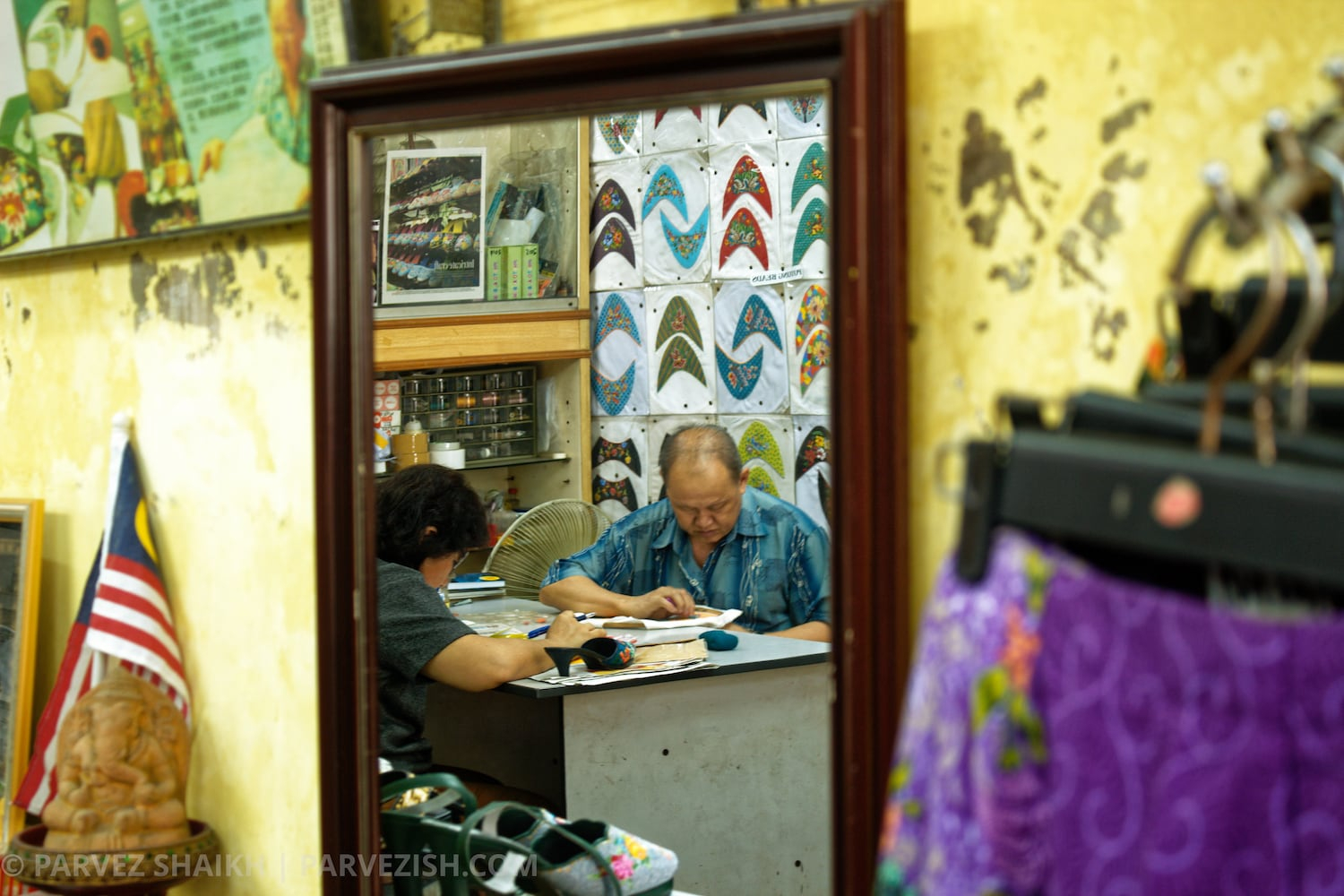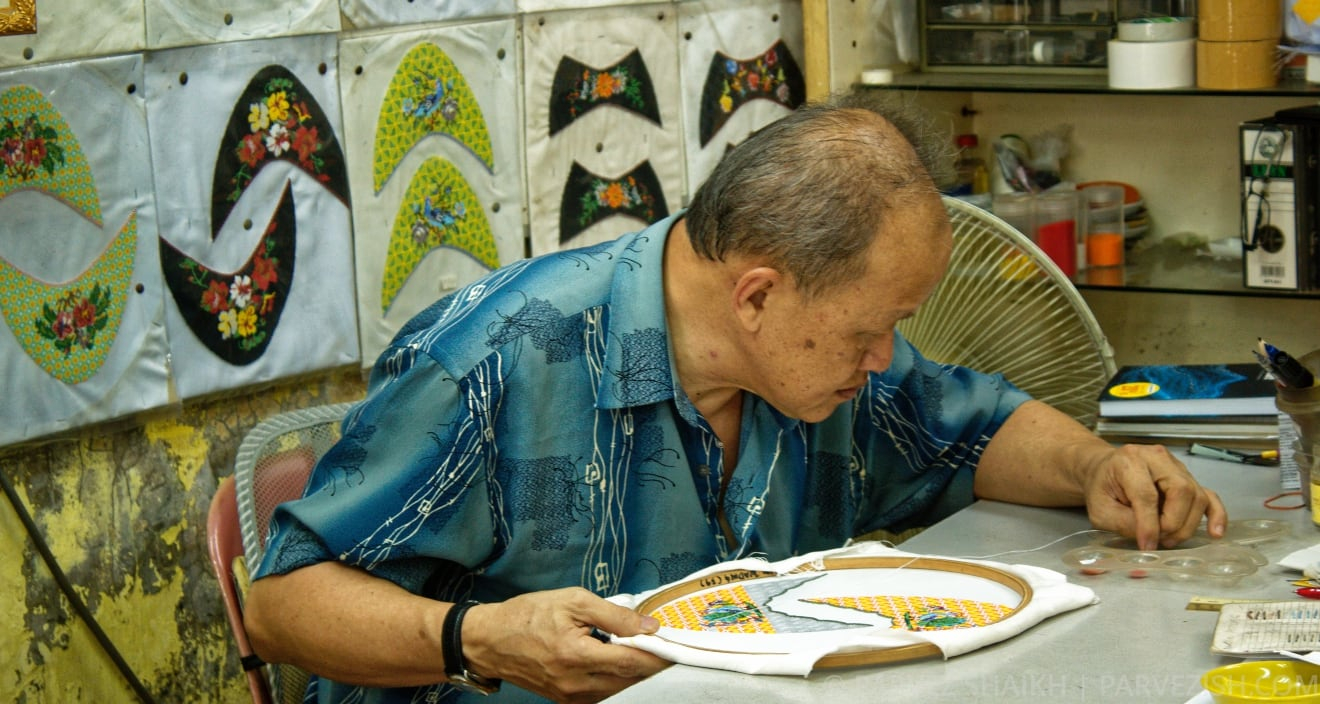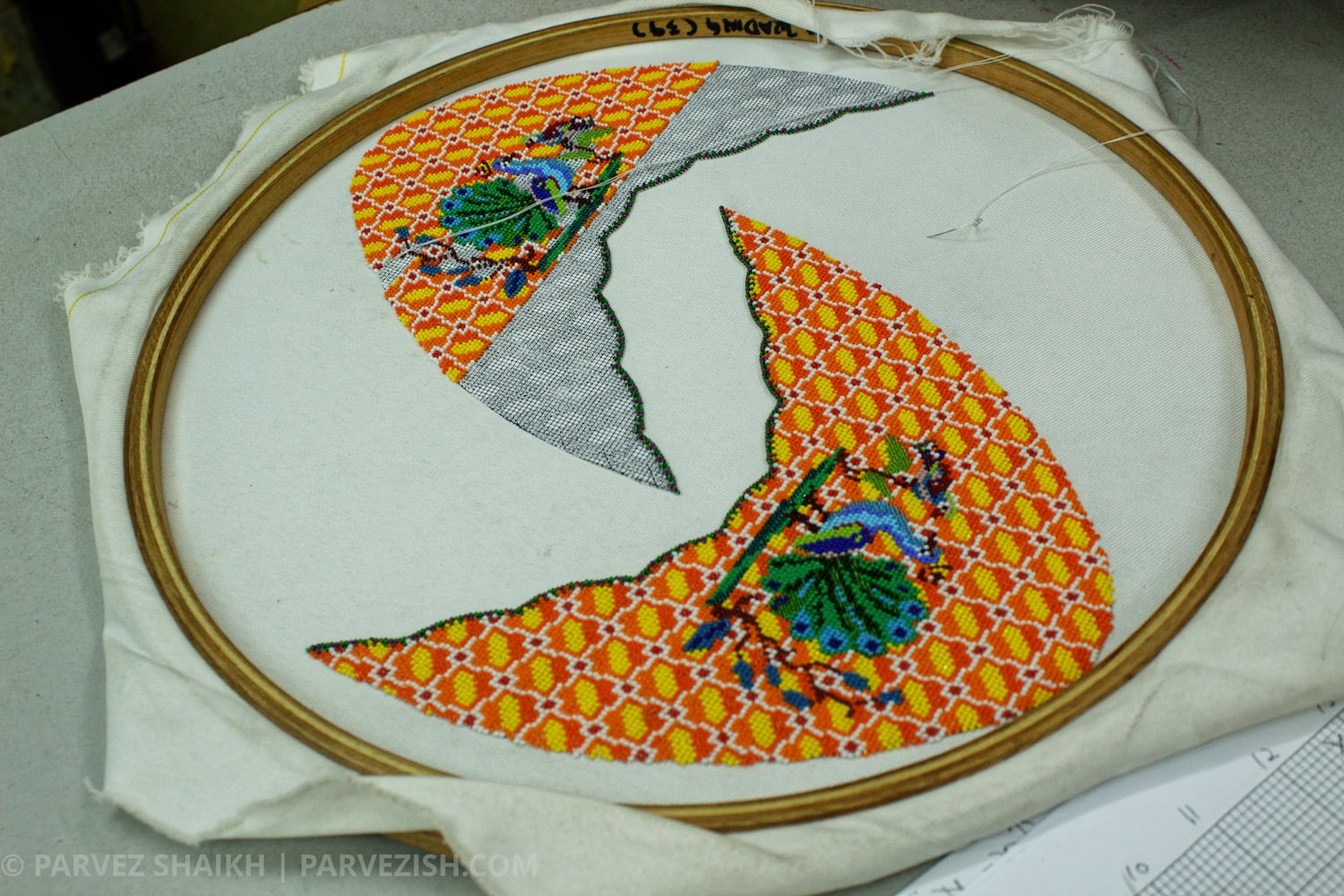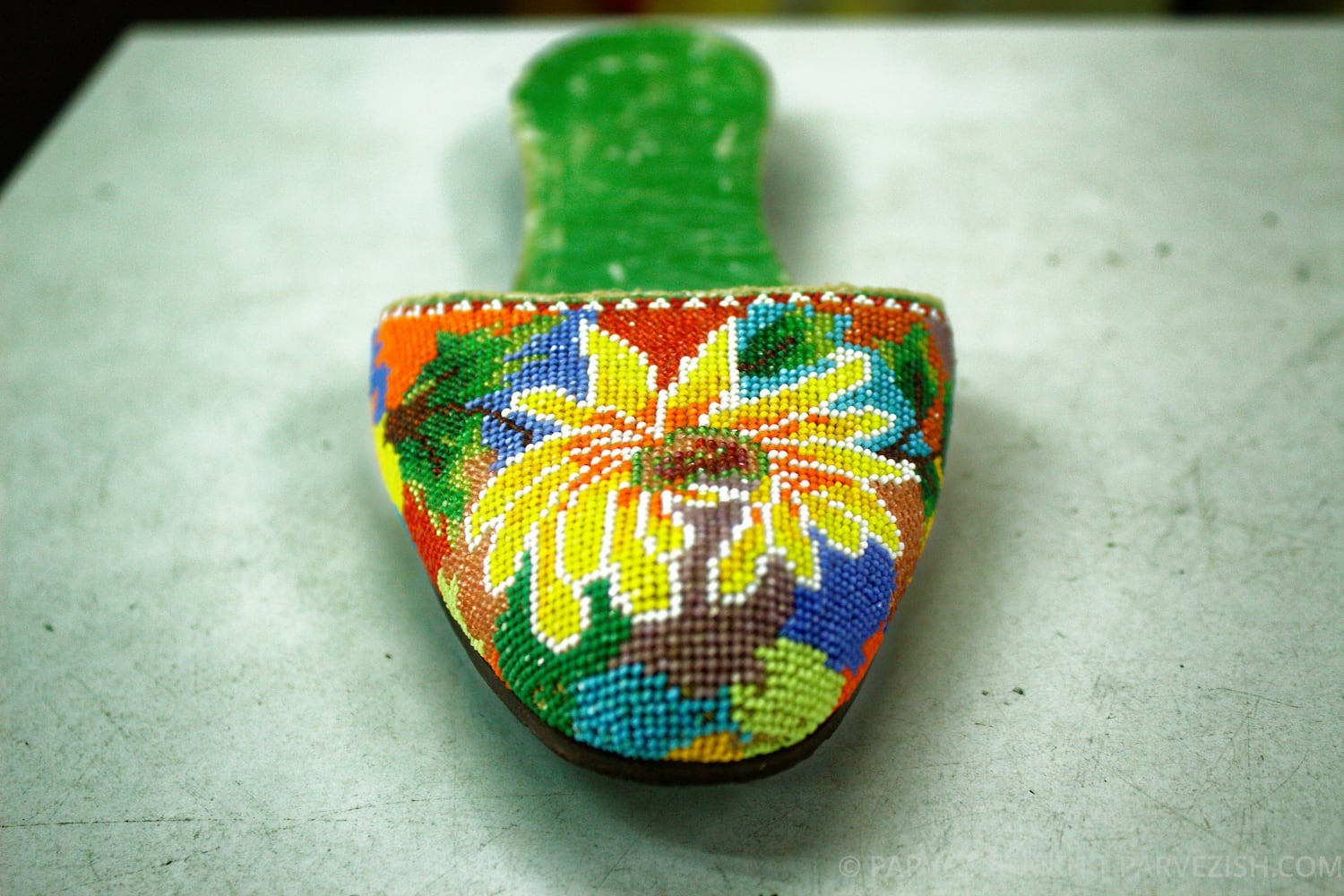After a warm welcome by a family in Kampung Ketek who invited me to a dinner the previous night, I spent the next day walking around the streets of Malacca. Jonker Street, which was bustling with tourists hovering over those street food stalls last night, seemed very quiet in the morning.
After having my coffee at Sin Sing Coffee, I walked further in search of some interesting places. I was told by locals and tourists a few days ago that Malacca was all about the Jonker Street night market on weekends. But I wasn’t quite convinced that this town had not much to offer.
After an aimless walk around the town on a hot and humid day, a shop caught my attention. There were some colourful shoes on display and I told myself that I had to take a closer look. I entered the shop and saw a man and a woman sitting inside. I walked around the shop looking at beautiful designs of those shoes.
As I wandered around the shop, the man and woman kept working, without looking at me. None of us said a word. I thought of leaving as they were clearly not looking for a window-shopper. But the beauty of those shoes had made me curious to learn more about them. So instead of leaving the shop, I decided to feed my curious brain. I introduced myself and finally began the conversation.
The work I was looking at is called Nyonya shoes, known locally as kasut manek which means ‘beaded shoes.’ The couple — T. S. Lim and Susan — was working on the next pair of those beautiful shoes. As they continued working, I engaged in an interesting conversation with them. During this conversation, I came to know about the Baba Nyonya culture, handmade Nyonya shoes, and the struggle of keeping the dying art alive.
Baba Nyonya aka Peranakan People: A Brief Introduction
Peranakan people are the descendants of Chinese immigrants who came to the Malay archipelago between the 15th and 17th centuries. In Malaysia, Peranakan people are known as ‘Baba and Nyonya’ where ‘Baba’ stands for men and ‘Nyonya’ for women. The term ‘Peranakan’ simply means ‘descendent’ in Malay and Indonesian.
After Zheng He aka Cheng Ho – a Chinese mariner, explorer, and admiral – visited Malacca in the early 15th century, close relations between Malacca and China were established. The growing relationship between the Sultan of Malacca and the Ming Dynasty of China resulted in a beautiful princess named Hang Li Po being sent to Malacca to marry the Sultan.

The claim of Hang Li Po being a real ‘princess’ is disputed but she brought with her 500 noblemen and some handmaidens who initially settled in Bukit China and eventually married Malay locals. These inter-race marriages marked the beginning of a new generation of people known as ‘Baba Nyonya.’
People known as Baba Nyonya adopted the local culture while still retaining some parts of their Chinese culture. They still celebrate festivals like the Chinese new year and the mooncake festival. In Malacca, you will often come across shops, museums, and restaurants who represent the Nyonya culture in the town.
Peranakan women in Malacca wear a beautiful dress called Nyonya Kebaya. Kebaya is a heavily-embroidered blouse dress usually made from materials such as silk, polyester, thin cotton or semi-transparent nylon. Kebaya is paired with a batik-print sarung or sometimes a long skirt. The Nyonya beaded shoes are worn with kebaya sarung to complete the outfit.
The Art of Handmade Nyonya Beaded Shoes
Lim explained the shoe-making process after I showed interest in their work. Susan showed me different designs they made on graph papers that are then reduced in size.
The process of making a pair of shoes from those tiny, colourful beads takes days – often months. Thanks to the quality of materials used, a well-crafted, hand-made pair of beaded shoes can last for decades, I was told. These shoes can be also be altered to change the sole while still keeping the same beads work.

The size and quality of the beads can make the Nyonya beaded shoes costlier to own. The smaller the beads, the more amount of work, and the more expensive the final product. It can take more than 15,000 tiny beads to give the desired look to the pair of shoes. Imagine the patience, concentration, and dedication that goes into the process.
The couple politely declined my request of clicking some photos of their shoes. “A lot of hard work goes into making these designs,” Lim told me. “People simply steal our designs and produce commercially.” But a few moments later, I was presented with an old shoe that was awaiting some alteration which they said I could photograph.
The Struggle Is Real
The struggle to keep the dying art of handmade Nyonya shoes is real. Lim showed me some materials which they used to get from India. The last company that made the specific kind of materials had stopped producing them — now making it difficult to find materials with similar quality.
Another hurdle in keeping the art alive is the newer generation’s lack of willingness. “It’s a dying art. It’s hard to make money from this,” said Susan with an understandable disappointment. “We are keeping this art alive but we want our children to study and get jobs instead.”

The price of a finely crafted, handmade Nyonya beaded shoe pair can go as high as 2500 Ringgits (around $600). The price depends on the design, quality of materials, and the amount of hard work that goes into bringing the shoes to reality. Not everyone can afford these shoes, of course. But those who know and appreciate this dying art are willing to pay for it, said Lim.
Their customers include people from the local Baba Nyonya community as well as visitors from other countries. These customers or should I say, admirers, are somehow helping keep the business running for Lim, Susan and other shoemakers like them.
Most visitors – especially the young ones – visiting the shop to take some photos return disappointed because of the ‘no photo’ policy in the shop.
“People nowadays don’t appreciate the effort that goes into making these designs,” Lim told me. “I get many visitors coming here saying they have ‘many followers’ on social media. They say they can help us ‘boost’ the business. I simply say no because we have had bitter experiences with the same in the past. We are doing good the way it is.”

I had one final look at those beautiful shoes before saying goodbye to Lim and Susan. They both got busy with their work – crafting a fine handmade pair of Nyonya beaded shoes as I left their shop in search of similar stories.
The Dying Art of Handmade Nyonya Beaded Shoes: Summary
Craftsmen and women like Lim and Susan are working hard to keep the art of handmade Nyonya shoes alive. With the next generation not very keen to adopt this craft as a skill, it’s hard to say how long will it survive. Moreover, the commercial production of beaded shoes using cheaper and less reliable materials like PVC have hampered the business for those who spend countless hours in making these fine pair of handmade shoes.
Beaded shoes have played important role in the dressing of Nyonya women. The beautiful combination of kebaya and sarung is certainly incomplete without a matching pair of Nyonya shoes. It’s hard, however, to keep the tradition going when the interest in Nyonya shoes is being lost.
What do you know about Baba and Nyonya culture? What are your thoughts and experiences about handmade Nyonya beaded shoes? Can this article be improved? Feel free to share your thoughts, experiences, and feedback with me.
Interested in visiting Lim and Susan’s shop? They can be found at Lim Trading, 63, Jalan Tokong, 75200, Malacca, Malaysia. Looking for a place to stay in Malacca? There are plenty of affordable hostels and hotels across the town.



